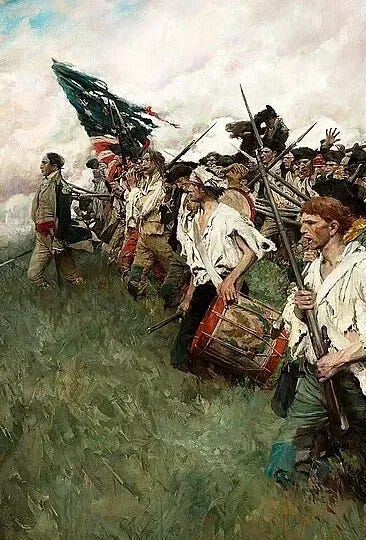Introduction
Historical accounts of the Revolutionary War rightly featured the lives of leaders and heroes. Every grade school student knows about General George Washington the Father of our country who led with conviction and courage, even during the winter at Valley Forge. Some may have learned of the exploits General Charles Scott and his brigade of tough Virginia militiamen. Ah, and what history buff hasn’t admired the courage of the Marquis de Lafayette the young French officer who fought alongside Washington’s army?
But history rarely features the story of the common soldier. For one thing, foot soldiers were occupied body and soul with the duties of soldiering. At the end of the day, rest and refueling were more important to them than taking time to write about their wartime experiences. Besides, some could neither read nor write. Fortunately, the fledging American army recorded the service of nearly every soldier from privates to generals who served in the Revolutionary War. It’s these dry facts and narrative scraps, buried in military records, that outline their stories. If we are lucky, one day a historian or a descendant will use that outline to write a story about a common soldier. That’s exactly what I did. After some digging, I located the records of at least four of my ancestors who served in the war. Fact by fact, I built on the bare bones of these long-dead men. Eventually, the lives of two men, both my 4th great grandfathers, began to take shape, to become real. After far too long, I am pleased to put down on paper the stories of these two patriots, Private Nathaniel Richard Martin and Private James William Murphy.
Chapter 10: Two Patriots
To Build an Army
On June 19, 1775 the Second Continental Congress named George Washington as Commander in Chief of the Continental Army tasking him to lead the fight against the British in a war already begun. But first he had to build an army. By the summer of 1776, Washington had pieced together an army of soldiers from all 13 colonies that over the eight years of the Revolutionary War would total some 231,000 men.
The Continental Army, by its nature as America’s first army, was green and undisciplined. At first the army was made up of colonial militias with each one under the authority of its own generals and senior officers. By the summer of 1776 most militias had been absorbed into regular army regiments much the way the British army was structured. Many of the army’s commanders had in fact served under the British during the French and Indian War, the Regulators War in North Carolina, and the Cherokee War. Many of the high-ranking officers were planters, while others were college educated lawyers and physicians. Washington, for example, a veteran of the French and Indian War, was also a surveyor.
In the beginning, Continental officers simply dressed in their best civilian clothes. Washington, though, quickly set the standard when he adopted French-inspired military uniforms, such as the more tailored "frock coat.” This early uniform was made of blue wool with white, red, or buff facings. Later, officers’ coats were trimmed with elaborate gold or silver lace with epaulettes indicating rank.
Rank and file soldiers, who were anywhere from fifteen to 45 years old, lacked the military experience of their officers. They came from all walks of life, but most were farmers and laborers. A majority was of British descent, but the ranks also included Native Americans and African Americans. Privates received $6.23 a month in pay, plus daily rations of 1.5 pounds of meat, a pound of bread, and two ounces of spirits.
At first the troops wore “work clothes,” clothing suitable for their military mission. Later the army adopted the linen hunting shirt as standard wear. Washington, who took interest in such things, praised the hunting shirt for its utilitarian and tactical use. “No dress can be cheaper, nor more convenient, as the wearer may be cool in the warm weather and warm in cool weather.” He believed the hunting shirt also would “carry no small terror to the enemy” fooling them into thinking every man to be a “complete marksman.”
Gen. Washington required all new recruits to be inoculated against smallpox. Washington, as a teenager, had contracted a mild case of smallpox in Barbados that left him bedridden for weeks and his face forever pockmarked. The scars from that early illness was a visible reminder of the deadly toll the disease could take on his troops, and ultimately jeopardize the war’s outcome. Inoculation involved the squeamish procedure of making a cut in the skin and implanting a pus-laden thread into the open wound. Even so, 5 to 10 percent of the patients died from the procedure. Washington’s caution would prove well-founded. Historians believe that the inoculation program, along with other public health efforts, helped reduce the percentage of sick soldiers in the army from a high of 35.5 percent to a low of 9 percent. Still, smallpox claimed 100,000 lives over the course of the Revolution.
I invite you to read “Unsettled” as it unfolds. Back chapters are available at Unsettled: Chapters, some include new essays on viewing history within today’s context. I’ll post each new chapter once it’s written and polished for publication. Writing is my joy. Thank you.
Next Up: Chapter 11, Nathaniel Richard Martin







Who knew that someone could write about the fashion of war and make it interesting. You did! Thank you dear sister.